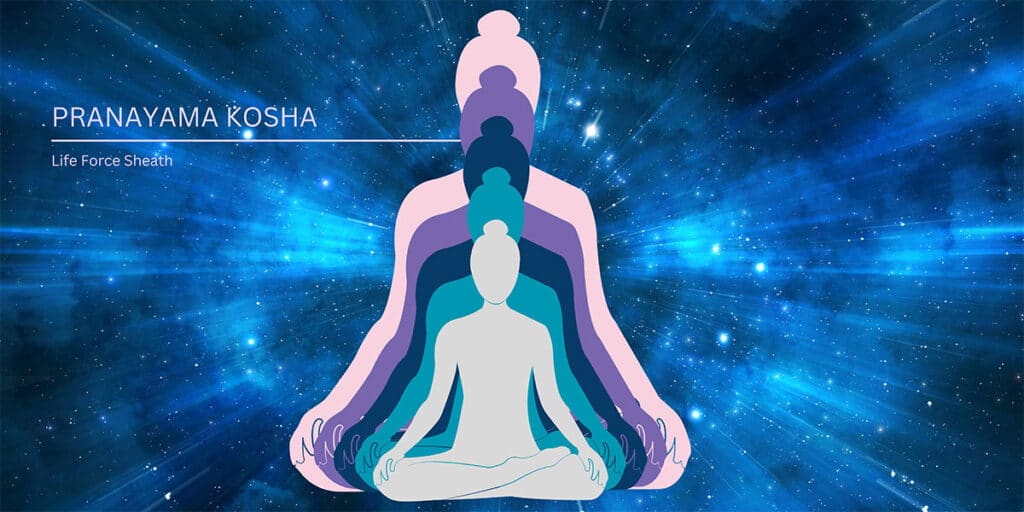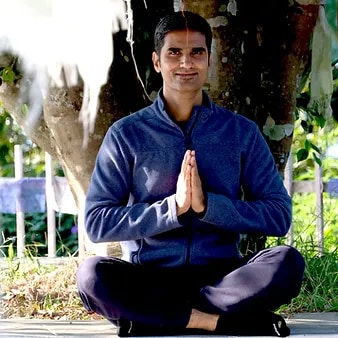Pranamaya Kosha: Understanding the Vital Energy Body
by Hardik Mehta

In the ancient yogic tradition, human existence is described through the concept of Pancha Kosha, or the five sheaths of the self. These layers represent different dimensions of our being, from the gross physical body to the innermost spiritual core. The second of these sheaths is the Pranamaya Kosha, the vital energy body, which governs life force or prana. This kosha bridges the physical and subtle realms, playing a crucial role in health, well-being, and spiritual growth.
In this blog, we will explore Pranamaya Kosha in depth, its significance, how to balance it, and how it influences our physical and mental states.
What is Pranamaya Kosha?
The term Pranamaya Kosha is derived from two Sanskrit words:
- Prana: Life force or vital energy that sustains the body and mind.
- Maya: Composed of or made up of.
- Kosha: Sheath or layer.
Thus, Pranamaya Kosha refers to the sheath made of prana. It is the energy that flows through the nadis (energy channels) and chakras (energy centres) in the body. This kosha regulates our breath, bodily functions, emotions, and mental clarity.
Importance of Pranamaya Kosha
The Pranamaya Kosha is responsible for:
- Regulating Life Force: It manages the energy flow in our body, affecting vitality and immunity.
- Maintaining Balance: It connects the physical body (Annamaya Kosha) with the mind (Manomaya Kosha), ensuring harmony.
- Enhancing Health: A balanced Pranamaya Kosha promotes physical well-being, mental clarity, and emotional stability.
- Spiritual Growth: It helps deepen meditation, allowing access to higher consciousness.
The Five Types of Pranas
Yogic philosophy divides prana into five main types, each responsible for different functions:
- Prana Vayu: Governs inhalation and energy absorption, located in the chest.
- Apana Vayu: Controls elimination and downward energy movement, found in the lower abdomen.
- Samana Vayu: Aids digestion and assimilation, centered around the navel.
- Udana Vayu: Facilitates speech, growth, and upward movement of energy, located in the throat and head.
- Vyana Vayu: Distributes energy throughout the body, supporting circulation and movement.
Understanding these pranas can help individuals regulate their health and emotions through proper breathing techniques and energy management.
Signs of an Imbalanced Pranamaya Kosha
When the Pranamaya Kosha is imbalanced, individuals may experience:
- Low Energy and Fatigue: Lack of enthusiasm, exhaustion, and frequent illnesses.
- Breath Irregularities: Shallow breathing, difficulty in deep breathing, or breathlessness.
- Emotional Instability: Anxiety, mood swings, or stress-related disorders.
- Physical Ailments: Poor circulation, digestive issues, or chronic pain.
- Mental Fog: Lack of clarity, poor concentration, and sluggishness.
How to Balance Pranamaya Kosha
To maintain a healthy Pranamaya Kosha, one must focus on breath control, energy flow, and holistic well-being. Here are some effective practices:
- Pranayama (Breathing Exercises)
Pranayama is the most powerful way to purify and strengthen the Pranamaya Kosha. Some effective techniques include:
- Nadi Shodhana (Alternate Nostril Breathing): Balances energy channels and enhances mental clarity.
- Bhastrika (Bellows Breath): Boosts energy and oxygenation.
- Ujjayi (Ocean Breath): Calms the nervous system and improves focus.
- Yoga Asanas (Postures)
Specific yoga poses can enhance pranic flow and strengthen this sheath. Recommended asanas include:
- Tadasana (Mountain Pose): Improves breath control and energy distribution.
- Bhujangasana (Cobra Pose): Opens the chest, allowing better oxygenation.
- Matsyasana (Fish Pose): Stimulates the throat chakra and deepens breathing.
- Shavasana (Corpse Pose): Helps in pranic absorption and relaxation.
- Meditation and Visualization
Practicing meditation with breath awareness strengthens the Pranamaya Kosha and enhances inner peace. Techniques include:
- Observing the Breath: Simply being aware of inhalation and exhalation.
- Chakra Meditation: Focusing on energy centers to align and balance prana.
- Mantra Chanting: Using vibrations like ‘OM’ to regulate pranic energy.
- Healthy Diet and Lifestyle
Consuming prana-rich foods and maintaining a balanced lifestyle also contribute to a healthy Pranamaya Kosha.
- Fresh Fruits & Vegetables: High in life force energy.
- Hydration: Drinking pure water aids pranic flow.
- Avoid Processed Foods: These deplete vital energy.
- Rest & Sleep: Proper rest rejuvenates pranic reserves.
- Connecting with Nature
Spending time outdoors, walking barefoot on grass, and practicing deep breathing in fresh air can help restore and balance the Pranamaya Kosha.
The Role of Pranamaya Kosha in Spiritual Growth
A purified and balanced Pranamaya Kosha acts as a bridge between the physical and mental realms. It enables deeper meditation, better intuition, and heightened spiritual awareness. Many yogic traditions emphasize breath control as a fundamental step towards enlightenment. When prana flows freely, it aids in the activation of higher consciousness.
The Pranamaya Kosha is an essential aspect of our existence, influencing physical vitality, mental stability, and spiritual evolution. By practicing pranayama, yoga, meditation, and a healthy lifestyle, we can enhance this vital sheath, leading to holistic well-being.
Regular awareness of our breath and energy flow can transform our lives, helping us achieve harmony between body, mind, and soul. Strengthening the Pranamaya Kosha is not just about good health; it’s about unlocking a deeper understanding of life itself.
If you’re looking to deepen your yoga practice and explore the Pancha Koshas further, consider enrolling in Sayujya Yoga’s 200-hour TTC program, which focuses on each layer of Pancha Kosha, breathwork, and energy alignment. A well-balanced Pranamaya Kosha can lead to a more fulfilled, vibrant, and conscious life.
About the Author

Hardik Mehta
Hardik is an E-RYT 500 & YACEP (Yoga Alliance Continuing Education Provider), Yoga Alliance, USA. He has been practicing yoga for the last 9 years. Prior to finding his true calling in Yoga, he was working with various corporates for 12 years in the Retail and eCommerce sector.
